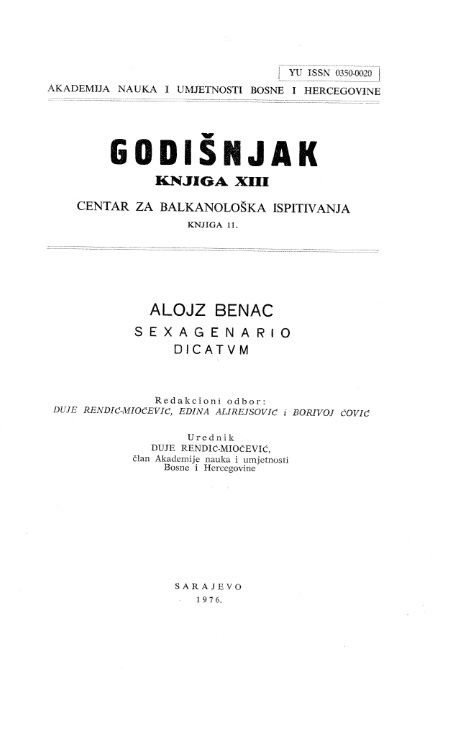Humke stepskih odlika na teritoriji Srbije
Mounds of Kurgan Character in Serbia
Author(s): Dragoslav SrejovićSubject(s): Archaeology, Customs / Folklore, Ethnohistory, Ancient World, Cultural Anthropology / Ethnology
Published by: Akademija Nauka i Umjetnosti Bosne i Hercegovine
Keywords: Mounds; Serbia; Kurgan character; graves; funeral customs;
Summary/Abstract: This paper describes three mounds of Kurgan character found in the vicinity of Kragujevac (central Serbia), The first of these, the mound at the village of Rogojevac, is heaped over two graves (PL I), i.e. above two stone boxes, each containing a burial laid supine with legs contracted upwards (Fig, 1). Both burials were sprinkled with ochre, and near one of them four small flint knives were found (Pl. II, 1—3, 13), Round the graves lay carbonized animal bones (ox, horse, dog, deer, wild boar), and about fifty potsherds (Pl. II, 4—12) typologically associated with the Hunyadi-halom/Vajska-Herculane II/III-Bubanj I b/II vessels (end of the 4th and the beginning of the 3rd millenium B.C.). Two mounds (Mound I and Mound 11) were explored at the village of Bare. Mound I contained a burial whose head was severed from the body (PL III). Four pottery vessels were laid near the body (only one has been preserved in its entirety — Pl. IV, 2), and golden jewelry, consisting of four circular buttons, five pendants, three rectangular plaques and 156 beads of various forms (Fig. 2, PL IV, 1, 4) was placed on the chest. This jewelry is very similar to the golden jewelry from Troy II-g and Tape Hissar (Pl. IV, 3, 5, an the pottery vessels from this mound (Pl. IV, 2; Figs. 3—5) are typologically close to the earthenware of the Černavoda II-Foltesti II culture. These analogies show that Mound I at Bare probably dates from c. 2300 B.C. Mound I I at Bare (Pl. V), although identical in structure with Mound I, displays two important new features: the body buried beneath it was burnt, and the earthenware placed in the burial pit (Pl. IV, 6) anticipates the pottery forms typical of Early Bronze Age cultures of the Vinkovci-Somogyvar and Belotić—Bela Crkva types. Therefore Mound I I at Bare should be dated into a period after 2300 and before 1900 B.C.
Journal: Godišnjak Centra za balkanološka ispitivanja
- Issue Year: 1976
- Issue No: 13
- Page Range: 117-130
- Page Count: 19
- Language: Serbian

